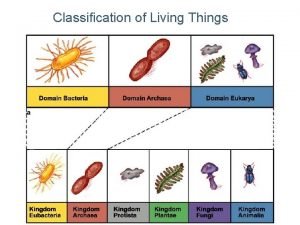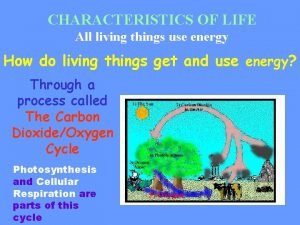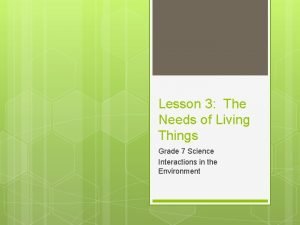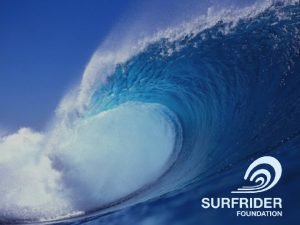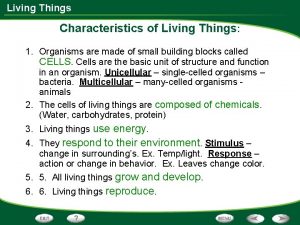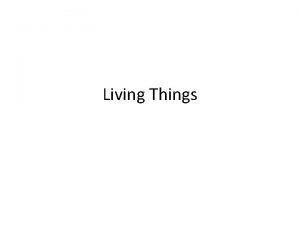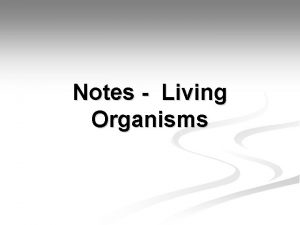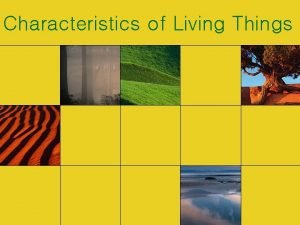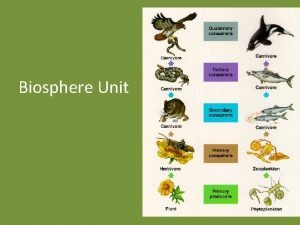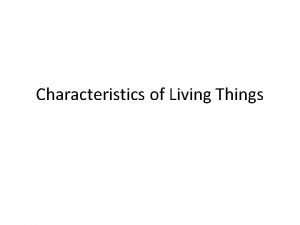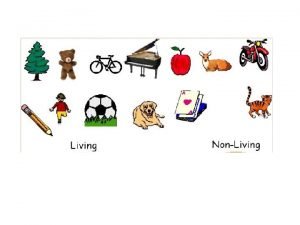Living Things Organisms Organisms are all living things












- Slides: 12

Living Things

Organisms • Organisms are all living things. Living and nonliving things that interact in a particular area make-up an ecosystem. Organisms live in a particular place in an ecosystem. • An organism obtains food, water, shelter, and other things it needs to live, grow, and reproduce from its surroundings. • All organisms need water. • Remember: Some organisms can make their own food through photosynthesis.

Habitat • An organism’s habitat is the place where an organism lives and that provides the things that the organism needs. • An organism interacts with both living and nonliving parts of its habitat. The living parts are called biotic factors. The nonliving parts are called abiotic factors. (ex: soil, water, sunlight, oxygen, & temp)

Species • A species is a group of organisms that are physically similar, can mate with each other, and produce offspring that can also mate and reproduce. • All the members of one species in a specific area are referred to as a population. All the different populations that live together in an area make up a community. • The smallest level of organization is a single organism, which belongs to a population that includes other members of its species. The population belongs to a community of different species. The community and abiotic factors form an ecosystem.

Ecology • The study of how living things interact with each other and with their environment is called ecology. • Ecologists , scientists who study ecology, look at how all the biotic and abiotic factors in an ecosystem are related. They study how organisms react to changes in their environment. Living things constantly interact with their surroundings, responding to changes in the conditions around them.

Photosynthesis • Plants use energy from light to power the process of photosynthesis. This takes place in the parts of a plant that contain chlorophyll. • Carbon dioxide gas from the air and water from the soil are the raw materials for photosynthesis. Sugar and oxygen are the products.

Respiration • Cells store and use energy in a way that is similar to how money works at the bank. You eat a meal (make a deposit into your body) and then the cells need energy, they make a withdrawal by breaking down the carbohydrates in the food to release energy. • The process by which cells obtain energy from glucose (a type of sugar) is called respiration. • Because living things need a continuous supply of energy, the cells of all living things carry out respiration continuously.

Respiration • The term respiration also is used to mean breathing, that is, moving air in and out of your lungs. To avoid confusion, the respiration that happens in the cells is usually referred to as cellular respiration.

Respiration • Like photosynthesis, respiration is a two-stage process. The first stage takes place in the cytoplasm of the organism’s cells. There, glucose molecules are broken down into smaller molecules. • The second stage of respiration takes place in the mitochondria. There, the small molecules are broken down into even smaller molecules. These chemical reactions require oxygen, and a great deal of energy is released. The other two products of respiration are carbon dioxide and water.

Aerobic vs Anaerobic • Living organisms use energy released by respiration for their life processes. There are two types of respiration – aerobic (which needs oxygen) and anaerobic (which doesn’t need oxygen).

Photosynthesis vs Respiration • Photosynthesis and respiration are often thought of as opposite processes. Together, these two processes form a cycle that keeps levels of oxygen and carbon dioxide fairly constant in the atmosphere.

 Mikael ferm
Mikael ferm What is the smallest living unit of life
What is the smallest living unit of life Life processes
Life processes Venn diagram of living and nonliving things
Venn diagram of living and nonliving things The 8 levels of classification
The 8 levels of classification Cell to tissue to organ to organ system to organism
Cell to tissue to organ to organ system to organism Life cycle of all living things
Life cycle of all living things What are the 5 basic needs of all living things
What are the 5 basic needs of all living things Different types of living organisms
Different types of living organisms Throwaway living
Throwaway living Name three lines
Name three lines Member of the same species
Member of the same species Unicellular/multicellular
Unicellular/multicellular




